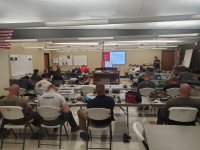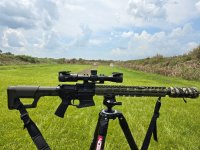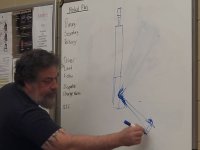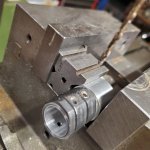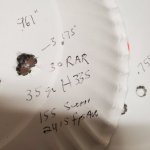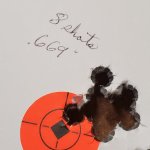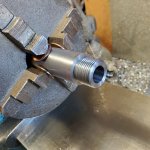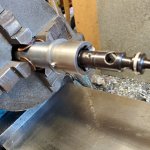I took the Sons of Liberty Gun Works (SOLGW) Armorer’s Class in Zachary, LA July 30-31. The class was taught by the owner, Mike, and one of his top armorers, Jesse. The class is billed as a top to bottom examination of the AR-15 platform, and it lives up to this. Mike was front and center the majority of the class and impressed me as a genuine expert in the field. Mike goes into the history of the platform, from the very beginning, and makes a real effort to give the student a comprehensive understanding of the system from back to front.
Day one is the lower, day two is the upper. You can take the class one of three ways – you can build a gun from parts to completion, you can tear an existing rifle all the way down and put it all the way back together, or you can take an existing rifle up and down as far as you see fit, i.e. many people chose to watch barrel / gas tube/ barrel nut / FSB / muzzle device installs as opposed to pulling their upper all the way apart – but it is your option.
Deciding which rifle to do surgery on was a real internal debate. I settled on my Fauveske. When I was conserving Grendel ammo, the main use was hogs and coyotes in South Texas, and it is what I think of as a classic 16” 5.56 carbine that mainly shoots green tip at nuisance animals. It is a frankengun – the upper is Noveske parts with a switchblock on a fluted Craddock Precision .750 stainless barrel, with a NHR rail Clark Custom Guns cut for the switch and assembled. It wears a 30 cal Thunderbeast Dominus. The results are super excellent, it generally holds sub 2” with green tip and is a sub MOA gun with match ammo. The lower is an early Lancer I built probably a decade ago – I thought it was a good option to see what I could have done better. It came out better than it went in.
Mike emphasizes the fire control group, bolt carrier group, buffer/spring and gas system are the areas that make or break the gun. The slowest, least interested, most distracted cell phone addicted student comes away aware of the basics - you're creating a hole, filling a hole, and you only use a roll pin once.
Each area is explored – the specifics of the fire control group, the individual parts in the LPK, the explanation of what mil-spec – “the most bastardized term in all of guns” – means. Mike gets into the metallurgy and why 6061 vs 7075 matters, why you don’t cut a sintered hammer trying to do a kitchen table trigger job and so forth. One neat thing about the class is that in general, if a rifle in the class was deemed to have a substandard part a SOLGW part was given as a replacement. One police department sent folks with Bushmasters and they were nearly half SOLGW parts by weight at the end of class.
If you take this class and build or tear your rifle down – you’ll leave with a gun that is built right.
Mike makes the point that heavier buffers with proper tungsten weights cost more, hence many guns carry basic carbine buffers. There is explanation of how we started with a 20” bbl gun using a 5.5 oz buffer – in carbines, the H2 is now the default minimum suggested buffer weight, but everything is based on total configuration. The point is made throughout the course that the gun is an algebra equation – what happens on one side (buffer and spring) must balance on the other side (gas system and bolt mass/speed).
Day two is about the upper, which you come to realize is about the barrel and the bolt; everything else is support staff. The barrel is the star of the show – everything is built around the barrel. The bolt, on the other hand, does all the work – it removes the brass from the hole and then fills it with a new round every single time you press the trigger. There is extensive discussion about the ejector, extractor and the 10 cent springs in them that make the gun run. Everyone in the class is given SOLGW extractor springs, which are visibly larger and stronger than stock. Everyone is given the opportunity to see if their ejector and spring are up to spec as well. It is heavily emphasized that those two parts and their springs are a huge part of the process. Mike discusses the metallurgy of bolts , 158 Carpenter vs 9130 etc, ad nauseum. If you nerd out over metals and finishes, you’ll be knee deep at least. He discusses the use of finishes on bolt carriers and how some are trash, while others have benefits but might nuke the steel i.e. if you have to get to 900 degrees to apply a finish - that might not be a universal good. Gas keys with nitride finishes were measured to determine which were undersized as a result of not being properly finished. My Noveske passed - they are machining or spec'ing them correctly - but others failed.
Mike proves some points about the difference between kitchen table guns, shit factory rifles, and top shelf factory rifles. This is summed up in the mating of three parts that are ultimately going to determine how the rifle runs = the fit of the barrel into the upper, and the fit of the gas block onto the barrel. The point is made by the discussion of tolerances and the allowable range – and resulting stacking. SOLGW measures and sorts for out of spec, high side and low side. Mike shows us what a properly sized barrel and gas block interface looks like – he taps it into place with a hammer. Then he shows a barrel that meets spec on the skinny side, and a gas block that is as wide as it can be to pass – and it spins around the barrel like a stripper on a pole. The barrel into upper fit is discussed as well and ultimately it is understood – if you buy parts for a kitchen table gun, you get what you get with regard to parts and how they happen to fit together with regard to tolerance stacking. A well built factory gun allows for the manufacturer to mate parts with the best fit and to put together the best 1000 guns out of a run of 1000 various parts vs the happenstance and hope method.
One interesting line of discussion with regard to the gas block. Mike has a strong opinion about the best way to attach the gas block – dimpled barrel with a 25 in/lb torque spec. He says he’s seen the “speed bumps” manifest inside the barrel on fine gauges beyond that - it is a thing. Deformation of the bore is also his beef with pinned units – he questions as to whether the stress of pinning may lead to the barrel toward having a pinched point. Clamp on blocks have screws that introduce yet another metal into the expansion equation seen between the block and barrel. Mike suggests either a 4150 barrel with a 4140 block or stainless/stainless for expansion purposes. Aluminum and Ti have significant differences from steel. What I found most interesting was that some higher end manufacturers are apparently going to thread on blocks with a locking nut. That makes all the sense, would minimize blow by and eliminate punching into the bore one way or another.
Muzzle devices and torque, myths, simple malfs, complex malfs – the list goes on. This class is about 16 hours of a data dump. I’ve built an AR or three prior to this, but I still bought a couple more tools prior to the class to make sure I could go from built to totally stripped to rebuilt. SOLGW sells a $400 tool kit that has everything a boy could need. They say good things about the Real Avid full kit – I had a combo of mainly Wheeler and Real Avid stuff and had zero issues with tools. I am absolutely more confident in my ability to build a better AR than I was before the class.
I could go on. If you take the class you get the power point in pdf if you bring a thumb drive, and you should bring a notebook as Mike drops a lot of knowledge along the way.
I came away believing SOLGW is serious about building fighting guns. Mike makes the point that there are fighting guns, competition guns, precision rifles, and pieces of shit built with the expectation they are unlikely to ever shoot any meaningful round count. He says if he were shooting a three gun championship, he’d probably pick up a JP. He’s complimentary of the competition when they’re doing it right and calls out actual examples of problems with the competition when their parts are before you in class and don’t meet spec. The class isn’t a SOL sales pitch outside of Mike demonstrating that the reason they have their basically unlimited warranty is they rarely have to fix anything because they’re built right to begin with. At the end of the class, you’ll understand that Mike has put thought into every – single – part from the origin story at Armalight to where it exists today in various forms and functions.
If you have the opportunity and interest, I would be surprised if you don’t learn a thing or three in this class. Five stars – I learned a number of things both days.
Day one is the lower, day two is the upper. You can take the class one of three ways – you can build a gun from parts to completion, you can tear an existing rifle all the way down and put it all the way back together, or you can take an existing rifle up and down as far as you see fit, i.e. many people chose to watch barrel / gas tube/ barrel nut / FSB / muzzle device installs as opposed to pulling their upper all the way apart – but it is your option.
Deciding which rifle to do surgery on was a real internal debate. I settled on my Fauveske. When I was conserving Grendel ammo, the main use was hogs and coyotes in South Texas, and it is what I think of as a classic 16” 5.56 carbine that mainly shoots green tip at nuisance animals. It is a frankengun – the upper is Noveske parts with a switchblock on a fluted Craddock Precision .750 stainless barrel, with a NHR rail Clark Custom Guns cut for the switch and assembled. It wears a 30 cal Thunderbeast Dominus. The results are super excellent, it generally holds sub 2” with green tip and is a sub MOA gun with match ammo. The lower is an early Lancer I built probably a decade ago – I thought it was a good option to see what I could have done better. It came out better than it went in.
Mike emphasizes the fire control group, bolt carrier group, buffer/spring and gas system are the areas that make or break the gun. The slowest, least interested, most distracted cell phone addicted student comes away aware of the basics - you're creating a hole, filling a hole, and you only use a roll pin once.
Each area is explored – the specifics of the fire control group, the individual parts in the LPK, the explanation of what mil-spec – “the most bastardized term in all of guns” – means. Mike gets into the metallurgy and why 6061 vs 7075 matters, why you don’t cut a sintered hammer trying to do a kitchen table trigger job and so forth. One neat thing about the class is that in general, if a rifle in the class was deemed to have a substandard part a SOLGW part was given as a replacement. One police department sent folks with Bushmasters and they were nearly half SOLGW parts by weight at the end of class.
If you take this class and build or tear your rifle down – you’ll leave with a gun that is built right.
Mike makes the point that heavier buffers with proper tungsten weights cost more, hence many guns carry basic carbine buffers. There is explanation of how we started with a 20” bbl gun using a 5.5 oz buffer – in carbines, the H2 is now the default minimum suggested buffer weight, but everything is based on total configuration. The point is made throughout the course that the gun is an algebra equation – what happens on one side (buffer and spring) must balance on the other side (gas system and bolt mass/speed).
Day two is about the upper, which you come to realize is about the barrel and the bolt; everything else is support staff. The barrel is the star of the show – everything is built around the barrel. The bolt, on the other hand, does all the work – it removes the brass from the hole and then fills it with a new round every single time you press the trigger. There is extensive discussion about the ejector, extractor and the 10 cent springs in them that make the gun run. Everyone in the class is given SOLGW extractor springs, which are visibly larger and stronger than stock. Everyone is given the opportunity to see if their ejector and spring are up to spec as well. It is heavily emphasized that those two parts and their springs are a huge part of the process. Mike discusses the metallurgy of bolts , 158 Carpenter vs 9130 etc, ad nauseum. If you nerd out over metals and finishes, you’ll be knee deep at least. He discusses the use of finishes on bolt carriers and how some are trash, while others have benefits but might nuke the steel i.e. if you have to get to 900 degrees to apply a finish - that might not be a universal good. Gas keys with nitride finishes were measured to determine which were undersized as a result of not being properly finished. My Noveske passed - they are machining or spec'ing them correctly - but others failed.
Mike proves some points about the difference between kitchen table guns, shit factory rifles, and top shelf factory rifles. This is summed up in the mating of three parts that are ultimately going to determine how the rifle runs = the fit of the barrel into the upper, and the fit of the gas block onto the barrel. The point is made by the discussion of tolerances and the allowable range – and resulting stacking. SOLGW measures and sorts for out of spec, high side and low side. Mike shows us what a properly sized barrel and gas block interface looks like – he taps it into place with a hammer. Then he shows a barrel that meets spec on the skinny side, and a gas block that is as wide as it can be to pass – and it spins around the barrel like a stripper on a pole. The barrel into upper fit is discussed as well and ultimately it is understood – if you buy parts for a kitchen table gun, you get what you get with regard to parts and how they happen to fit together with regard to tolerance stacking. A well built factory gun allows for the manufacturer to mate parts with the best fit and to put together the best 1000 guns out of a run of 1000 various parts vs the happenstance and hope method.
One interesting line of discussion with regard to the gas block. Mike has a strong opinion about the best way to attach the gas block – dimpled barrel with a 25 in/lb torque spec. He says he’s seen the “speed bumps” manifest inside the barrel on fine gauges beyond that - it is a thing. Deformation of the bore is also his beef with pinned units – he questions as to whether the stress of pinning may lead to the barrel toward having a pinched point. Clamp on blocks have screws that introduce yet another metal into the expansion equation seen between the block and barrel. Mike suggests either a 4150 barrel with a 4140 block or stainless/stainless for expansion purposes. Aluminum and Ti have significant differences from steel. What I found most interesting was that some higher end manufacturers are apparently going to thread on blocks with a locking nut. That makes all the sense, would minimize blow by and eliminate punching into the bore one way or another.
Muzzle devices and torque, myths, simple malfs, complex malfs – the list goes on. This class is about 16 hours of a data dump. I’ve built an AR or three prior to this, but I still bought a couple more tools prior to the class to make sure I could go from built to totally stripped to rebuilt. SOLGW sells a $400 tool kit that has everything a boy could need. They say good things about the Real Avid full kit – I had a combo of mainly Wheeler and Real Avid stuff and had zero issues with tools. I am absolutely more confident in my ability to build a better AR than I was before the class.
I could go on. If you take the class you get the power point in pdf if you bring a thumb drive, and you should bring a notebook as Mike drops a lot of knowledge along the way.
I came away believing SOLGW is serious about building fighting guns. Mike makes the point that there are fighting guns, competition guns, precision rifles, and pieces of shit built with the expectation they are unlikely to ever shoot any meaningful round count. He says if he were shooting a three gun championship, he’d probably pick up a JP. He’s complimentary of the competition when they’re doing it right and calls out actual examples of problems with the competition when their parts are before you in class and don’t meet spec. The class isn’t a SOL sales pitch outside of Mike demonstrating that the reason they have their basically unlimited warranty is they rarely have to fix anything because they’re built right to begin with. At the end of the class, you’ll understand that Mike has put thought into every – single – part from the origin story at Armalight to where it exists today in various forms and functions.
If you have the opportunity and interest, I would be surprised if you don’t learn a thing or three in this class. Five stars – I learned a number of things both days.
Attachments
Last edited:

